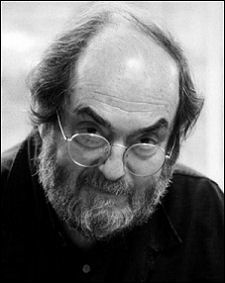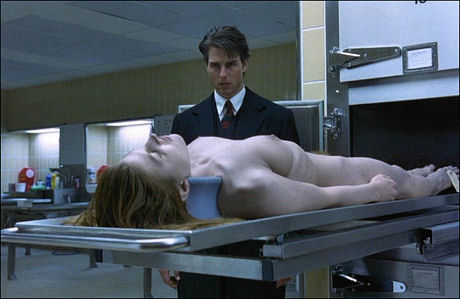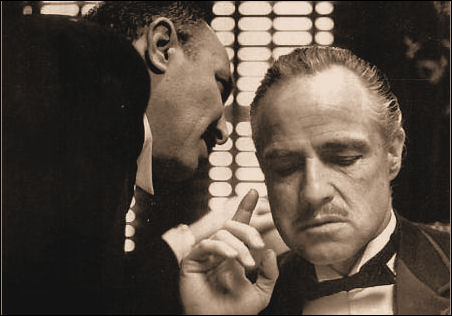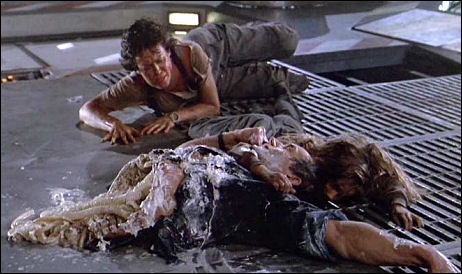Mel Watkins‘ N.Y. Times obituary for the great George Carlin, who passed earlier this evening at age 71.
Day: June 22, 2008
Priceline
I’d like to think that a citizen-artist adjusted the prices on a real-life sign at an actual gas station, rather than some guy Photoshopping it in his basement. I’d also love to find a larger photo of this shot. If anybody has a link…

Misfits Footage
I have a special passion for color photos and color behind-the-scenes photography of famous Hollywood films shot in black-and-white. Which tend to turn up in the special features of DVDs of the films in question. Some Like It Hot, From Here to Eternity, Gunga Din, etc. The owners have given or sold the footage to the DVD producers. Some, like this 8mm color film taken on the set of The Misfits, has turned up on YouTube, although for quality reasons we prefer 16mm color footage at all times.
It just seems odd that someone would pay $60 grand for the original 8mm footage of same. I mean, you just click on YouTube and there it is. If money was an object, why did the owner-seller of the silent 8mm footage keep it off the market for so many years (or decades) instead of trying to sell it 20 or 30 years ago, or peddle it to the producers of the Misfits DVD?
The footage is contained in a 47-minute film, “On the Set with The Misfits,” which was shot by film extra Stanley Floyd Kilarr. Candid-but-posed moments with Marilyn Monroe, Clark Gable, Montgomery Clift, Eli Wallach, Thelma Ritter and director John Huston.
Slammin’ Shut
I remember writing two or three pieces in ’99 and ’00 about how Eyes Wide Shut was a fascinating stiff that essentially portrayed of the decline of Stanley Kubrick. I remember bully-boy David Poland unloading ridicule in my direction because of this. All to say that it gave me comfort to come upon a similar judgment in David Thomson‘s re-review of Kubrick’s final film, which is found on page 273 of Have You Seen…?.


David Thomson, Stanley Kubrick
Here’s the first paragraph and two sentences at the article’s end:
“This is the last film of Stanley Kubrick — indeed, he died so soon after delivery of his cut that the legend quickly grew that he intended doing more things to his movie. But it’s hard at the end not to see the substantial gulf between the man who knew “everything” about filmmaking but not nearly enough about life or love or sex (somehow, over the years those subjects did get left out). Not that the film lacks intrigue or suggestiveness. Mastery can be felt. It is just that the master seems to have forgotten, or given up on figuring out, why mastery should be any more valuable than supremacy at chess or French polishing.”
The last two lines of Thomson’s review: “It is a shock to find that the film is only 159 minutes. Every frame feels like a prison.”
Very succinct. Here’s a March 2000 piece I wrote for Reel.com column that says the same thing with more words. It was called “Stanley Was Slippin’.”

“I [once] referred to Eyes Wide Shut as a ‘perfectly white tablecloth.’ That implies purity of content and purpose, which it clearly has. But Eyes Wide Shut is also a tablecloth that feels stiff and unnatural from too much starch.
“Stanley Kubrick was one of the great cinematic geniuses of the 20th century, but on a personal level he wound up isolating himself, I feel, to the detriment of his art. The beloved, bearded hermit so admired by Tom Cruise and Steven Spielberg (both of whom give great interviews on the Eyes Wide Shut DVD) had become, to a certain extent, an old fogey who didn’t really get the world anymore.
“Not that he wanted or needed to. He created in his films worlds that were poetically whole and self-balancing on their own aesthetic terms. But as time went on, they became more and more porcelain and pristine, and less flesh-and-blood. Eyes Wide Shut is probably the most porcelain of them all.
“The lesson is simple: If you want your art to matter, stay in touch with the world. Keep in the human drama, take walks, go to baseball games, chase women, argue with waiters, ride motorcycles, hang out with children, play poker, visit Paris as often as possible and always keep in touch with the craggy old guy with the bad cough who runs the news stand.
“Kubrick apparently did very little of this. The more invested he became in his secretive, secluded, every-detail-controlled, nothing-left-to-chance lifestyle in England — which he began to construct when he left Hollywood and moved there in the early ’60s — and the less familiar he became with the rude hustle-bustle of life on the outside, the more rigid and formalized and apart-from-life his films became.

“Kubrick’s movies were always impressively detailed and beautifully realized. They’ve always imposed a certain trance-like spell — an altogetherness and aesthetic unity common to the work of any major artist.
“What Kubrick chose to create is not being questioned here. On their own terms, his films are masterful. But choosing to isolate yourself from the unruly push-pull of life can have a calcifying effect upon your art.
“Kubrick was less Olympian and more loosey-goosey when he made his early films in the `50s (Fear and Desire, The Killing, Paths of Glory) and early `60s (Lolita, Dr. Strangelove). I’m not saying his ultra-arty period that began with 2001: A Space Odyssey and continued until his death with A Clockwork Orange, Barry Lyndon, The Shining, Full Metal Jacket and Eyes Wide Shut, resulted in lesser films. The opposite is probably true.
“I’m saying that however beautiful and mesmerizing they were on their own terms, these last six films of Kubrick’s were more and more unto themselves, lacking that reflective, straight-from-the-hurlyburly quality that makes any work of expression seem more vital and alive.
“So many things about Eyes Wide Shut irritate me. Don’t get me started. So many others have riffed on this.
“The stiff, phoney-baloney way everyone talks to one another. The unmistakable feeling that the world it presents is much closer to 1920s Vienna (where the original Arthur Schnitzler novel was set) than modern-day Manhattan. The babysitter calling Cruise and Kidman ‘Mr. Harford’ and ‘Mrs. Harford.’ If there is one teenaged Manhattan babysitter who has ever expressed herself like a finishing school graduate of 1952 and addressed a modern Manhattan couple in their early 30s as ‘Mr.’ and ‘Mrs.,’ I will eat the throw rug in Dave Poland’s apartment. The trite cliches that constitute 85% of Cruise’s dialogue. The agonizingly stilted delivery that Nicole Kidman gives to her lines in the sequence in which she’s smoking pot and arguing with Cruise in their bedroom. That absolutely hateful piano chord that keeps banging away in Act Three.

“The ultimate proof that Kubrick was off his game in his final days? He was so wrong in his judgment that the MPAA wouldn’t hit him with an NC-17 rating for the orgy scene that he didn’t even shoot alternative footage he could use in the event he might be forced to prune the overt nudity. He was instead caught with his pants down and forced to resort to a ridiculous CGI cover-up that makes no sense in the context of the film. (Would Cruise’s sexually curious character be content with just seeing the shoulders and legs of the sexual performers as he walks through the mansion? Wouldn’t he make a point of actually seeing the real action?)
“No one has been blunt enough to say it, but Kubrick obviously played his cards like no one who had any serious understanding of the moral leanings of the culture, let alone a good poker player’s sense of the film business, would have. He played them like an old man whose instincts were failing him, and thereby put himself and Warner Brothers into an embarrassing position. I wish things hadn’t ended this way for him, but they did.
“I hope what I’ve written here isn’t misread. I’ll always be grateful to have lived in a world that included the films of Stanley Kubrick. He’s now in the company of Griffith, Lubitsch, Chaplin, Eisenstein and the rest. Prolific or spare, rich or struggling, lauded or derided as their artistic strivings may have been, they are all equal now.”
Have You Seen?
David Thomson, who is usually my favorite film critic-essayist, has written another huge anthology work (somewhat similar to his The New Biographical Dictionary of Film) running 1024 pages called Have You Seen…?: A Personal Introduction to 1000 Films (Knopf). It won’t hit the stores until 10.24, but uncorrected proofs have been sent out, and I’ve been sinking into my copy with pleasure off and on or the last 48 hours or so.

The book is basically about Thomson going back to each and every film and making them seem curiously fresh and vital again. (And therefore necessary to see once more.) Each re-review and re-assessment runs four or five long paragraphs, and are composed with such smooth and clever assurance that you can knock off 25 or 30 in a single sitting and then return the next day, hungry for more. At no point do you have a feeling that he’s recycled past writings (even if he has here and there).
Here’s a two-paragraph taste of his page 17 take on Aliens:
“Generally speaking, the industrial strategy known as franchising — of doing sequels until the end of time — was a disaster in the 1980s and 1990s. But every now and then, something quite wonderful came of the plodding method. If you put Alien and Aliens side by side (and it may be one of the last great double bills in American film), you get not just the thumping and very satisfactory sequence of prolonged combat after great unnerving threat.
“You also get the emergence of the secret love story in these Alien pictures, the way in which no matter what happens in her movie career, Sigourney Weaver is never going to meet a more faithful lover than the creature. Indeed, its only rivals were the gorillas in the mist.
“Ripley comes back from the first film like Sleeping Beauty in her spacecraft. She looks lovely still, but the journey has taken fifty-seven years. She is brought back to Earth’s drab reality, but she has nightmares. And then she hears that the planet that [Alien‘s] Nostromo went to — it is called LV-426 now — has a small community of miners on it, a few families. And now, as Ripley comes home and wakes after fifty-seven years, the regular signal from LV-426 cuts out. Is there a clearer way the Alien has of calling to Ripley?”

The only thing missing is at least a glancing acknowledgment of the eight-year tragedy of Aliens director Jim Cameron — a guy who was good and imaginative and tough enough to make this film, both Terminator movies, The Abyss and Titanic over a brilliant 13 year stretch (’84 to ’97) and then….nothing.
Cameron is back on it now, somewhat, but for at least eight years he retreated into a kind of rich-man’s sandbox retirement that involved a lot of deep diving, a 3-D documentary, more diving and a lot of kicking back. In short, a complete abdication-renunciation of what he had it in him to do — a Napoleonic retreat from the task of creating smart and exciting movies that matter.
The navel-doodling that guided Cameron from ’98 to ’05 (or ’06) was, for me, shattering. Where would the world be if other men and women of strength and vision in other fields followed Cameron’s example? Think about that.
Ongoing Tragicomedy
Nikki Finke isn’t assessing the catastrophic Nailed shoot with the right spirit. When a film has been shut down for the fourth time because people aren’t getting paid, it might as well be the fifth or the eighth or the twelfth time. This level of repetition pushes events out of the agony realm and into that of near-farce. Meaning that a Lost in La Mancha-styled doc about the making of Nailed could be an inspired tragi-comedy.
This hasn’t been an “indie film shoot from hell,” as Finke has put it, as much as a gift to whomever has had the moxie and foresight to shoot it all (including interviews with ThinkFilm’s Mark Urman and Capitol Films’ David Bergstein) and cut it into something special. The doc that could result might turn out to be better than Nailed itself.
The main-character role that Terry Gilliam played in Lost in La Mancha could be split in the Nailed doc between Urman (the impassioned, frank-talking realist) and director David O. Russell (the gifted filmmaker fueled by anger, aggression and a comic appreciation of the absurd). One thing I would definitely want to see in this doc would be Urman saying the following (which is taken from Anthony Kaufman‘s 6.19.08 Indiewire piece about the ThinkFilm meltdown) straight to the camera, and with feeling.
“I feel terrible if people are hurt by our financial problems. We’re not moving forward on other people’s blood, I can assure you. We’re not [expletive deleted] people — we’re in trouble. And if people end up getting [expletive deleted], we’re [expletive deleted], too, and we can all be on the unemployment lines together.”
